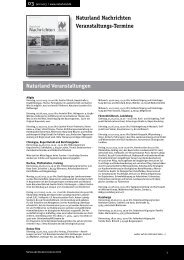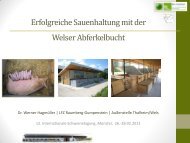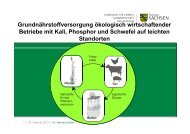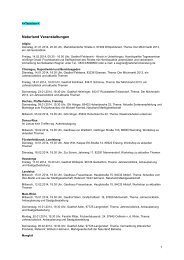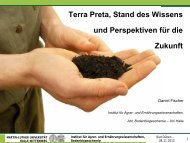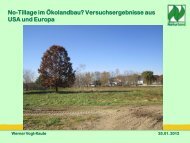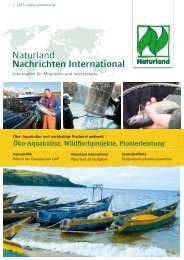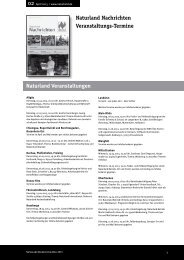Organic Farming in the Tropics and Subtropics: Sesame - Naturland
Organic Farming in the Tropics and Subtropics: Sesame - Naturland
Organic Farming in the Tropics and Subtropics: Sesame - Naturland
You also want an ePaper? Increase the reach of your titles
YUMPU automatically turns print PDFs into web optimized ePapers that Google loves.
II Special section: <strong>Organic</strong> Cultivation of <strong>Sesame</strong><br />
Examples of green manur<strong>in</strong>g plants that have been used <strong>in</strong> sesame crop rotation<br />
systems <strong>in</strong> Central <strong>and</strong> South America 11 12 :<br />
Plant type Characteristics<br />
Mucuna pruriens<br />
Velvet bean<br />
Canavalia ensiformis<br />
Jack or giant bean<br />
Dolichos lablab<br />
Hyac<strong>in</strong>th beans<br />
Vigna radiata<br />
Mungo<br />
Pueraria<br />
phaseoloides<br />
Kudzu v<strong>in</strong>e<br />
Good for re-cultivation after many years of fallow, with its strong<br />
climb<strong>in</strong>g properties. Suppresses weeds, e.g. tall grasses. Dies after<br />
seeds have ripened <strong>and</strong> when frost appears. Foliage <strong>and</strong> seeds<br />
good as fodder. Medium resistance to drought. Vegetation period up<br />
to 12 months.<br />
Drought resistant. Climber or creeper – depend<strong>in</strong>g on variety. Good<br />
weed suppresser with sufficient water, high resistance to pests <strong>and</strong><br />
disease.<br />
Climber or creeper. Excellent fodder. Only edible after much<br />
cook<strong>in</strong>g. Highly adaptable, from arid to humid. Good weed<br />
suppresser. Host plant for Phaseolus pests.<br />
W<strong>in</strong>d<strong>in</strong>g <strong>and</strong> bushy varieties, rapid growth, short vegetation period<br />
of 45 days – <strong>the</strong>refore, good weed suppresser. Resistant to drought<br />
<strong>and</strong> pests. Sown <strong>in</strong> rows between crop, or spread around 30 kg/ha.<br />
Strongly sarmentous, flat grow<strong>in</strong>g plant with 7 m long stolons,<br />
Suitable as bottom crop. Strong growth, good weed suppresser.<br />
Good fodder. Only suitable for wet sites.<br />
2.6. Biological methods of plant protection<br />
2.6.1. Diseases <strong>and</strong> methods of prevention <strong>and</strong> combat<strong>in</strong>g <strong>the</strong>m<br />
Moist conditions are especially conducive to fungi <strong>and</strong> bacterial growth. In order to<br />
prevent this, sites should be chosen which are well-dra<strong>in</strong>ed, levelled <strong>and</strong> which have<br />
deep, loose soil – <strong>in</strong> order to avoid water-logg<strong>in</strong>g<br />
11 AGRODESA (1997): Manual de ajonjolí orgánico. San Salvador.<br />
12 CLUSA (1995): Producción orgánica de ajonjolí. Serie de documentos técnicos, Managua.<br />
Naturl<strong>and</strong> e.V. – 1 st edition 2000 Page 10






